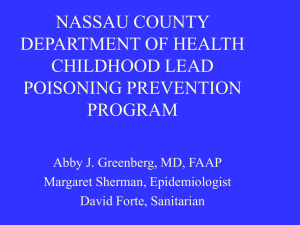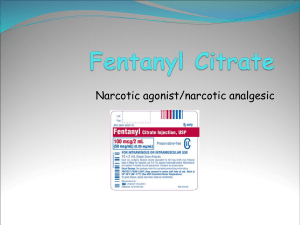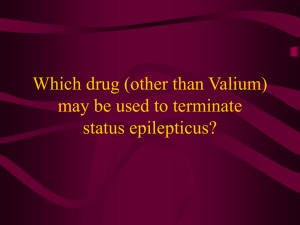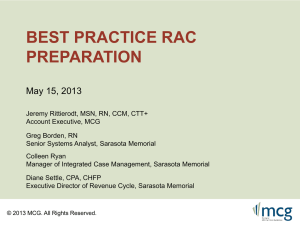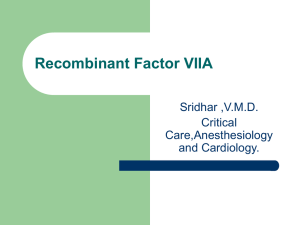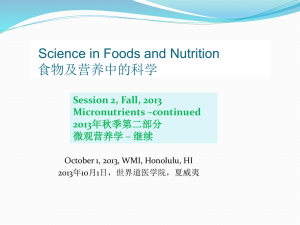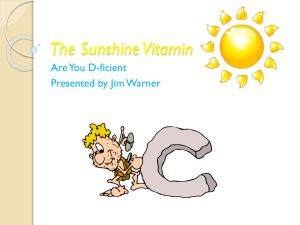CAPTEX T2
advertisement
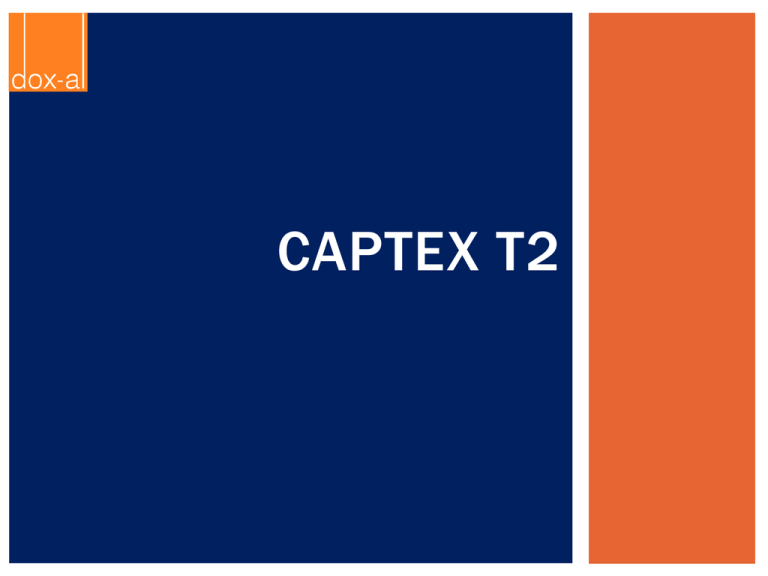
CAPTEX T2 EFFECT OF THE DIFFERENT MYCOTOXINS IN ON THE DIFFERENT FARMED ANIMALS SPECIES • Poultry 1. Broilers 2. Layers 3. Breeder • Sheep • Goats • Fish • Shrimp Mycotoxins • Aflatoxin (AFB) • Fumonisin (FB) • Ochratoxin (OTA) • T-2 Toxin (T-2) • Zearalenone (ZEN) • Vomitoxin or Deoxynivalenol (DON) MYCOTOXIN CONCENTRATIONS IN COMPLETE FEED IN EUROPE (318 samples from 10 countries, 2012) FEED AF FUMONISI N OT A T2 DON ZEA % positive samples 84 66 65 39 57 37 Av. Concentration (ppb) 18 106 21 18 111 76 HOW DOES CAPTEX T2 DEACTIVATES MYCOTOXINS (MODE OF ACTION) 3 different strategies to counteract a broad spectrum of mycotoxins 1. Preventing further mold growth 2. Adsorption by minerals 3. Biotransformation by enzymatic activity 1. PREVENTING FURTHER MOLD GROWTH Sodium Propionate acts as a mold inhibitor to prevent mold growth and proliferation minimizes risk of having mycotoxin-producing molds further proliferating in feed. has no activity against mycotoxins, but, always, when you ascertain mycotoxins presence, there is still a residual presence of molds. 1. PREVENTING FURTHER MOLD GROWTH Minimum inhibitory concentration of propionic acid (g/kg diet) on bacteria and molds Bacteria Propionic Molds Propionic Salmonella typhimurium 1.5 Aspergillus Niger 2.5 Pseudomonas aeroginosa 2.0 Penicillum expansum 1.3 Escherichia coli 2.0 Fusarium nivale 1.3 Staphylococcus aureus 2.5 Cladosporium sp. 2.5 Listeria monocytogenes 2.0 Campylobcter jejuni 2.0 Clostridum botulinum 2.5 Clostridum perfringes 2.5 2. ADSORPTION BY MINERALS CAPTEX T2 contains 2 main aluminosilicates 1. Calcium Bentonite (montmorillonite) 2. Zeolite (clinoptilolite) 2. ABSORPTION BY MINERALS BENTONITE / MONTMORILLONITE originally created from the breakdown (weathering) of volcanic ash. is a silicate with a layered polar crystalline microstructure which adsorbs organic substances either on its external surfaces or within its interlaminar spaces. Used to bind mainly Aflatoxin. 2. ABSORPTION BY MINERALS MOLECULAR STRUCTURES OF BENTONITE (MONTMORILLONITE) 2:1 clay structure: one octahedral sheet sandwiched between two tetrahedral sheets The mycotoxins that are bound by the montmorillonite are those that can physically enter into the interlayer space. The width of the interlayer space is 0.25 to 0.7 nanometers in the dry state and 1 nanometer in the hydrated state. Aflatoxins and ochratoxins can enter into this space 2. ABSORPTION BY MINERALS ZEOLITES / CLINOPTILOLITE is of (sea or lake) sedimentation origin with a unique, complex crystalline structure. honeycomb (tetrahedral) framework of cavities and channels act like cages, trapping mycotoxins. Used to deactivate Zearalenone, Ochratoxin and Fumonisin. 2. ABSORPTION BY MINERALS MOLECULAR STRUCTURES OF CLINOPTILOLITE 3-dimentional crystalline Structure with an 8-ring and 10-ring channels has a cage-like structure, with pores and channels running through the crystal. The cage and surrounding mineral carries a net negative charge, making it one of the few negatively charged minerals found in nature 2. ABSORPTION BY MINERALS MOLECULAR STRUCTURES OF BENTONITE (CLINOPTILOLITE) Because of its cage-like structure and negative charge, clinoptilolite has the ability to draw and trap within and on itself positively charged toxic particles that fit into the pores and channels of the cage It acts as molecular sieves and absorb substances of a low-molecular compounds (mycotoxins) Used to adsorb Zearalenone, Ochratoxin and Fumonisin, Deoxynivalenol 2. ABSORPTION BY MINERALS CAPTEX Belongs to a new generation of mycotoxin deactivators, which are classified as highly purified and activated clays. The minerals undergo a special process that involves; Physical treatment (Micronisation) Chemical treatment which greatly increases its adsorbent efficiency 2. ABSORPTION BY MINERALS PHYSICAL TREATMENT AND ACTIVE SURFACE OF CAPTEX T2 The high af finity of binding is due to the fact that the product is modified by the micronisation process to be extremely fine, 150,000 particles/gram. This provides for a larger surface area that increases the possibility of interacting with mycotoxins. Though extremely fine, caution is given not to have any particles size of less than 5 microns in order to avoid dustiness as well as inhalation issues with the people that are handling the product. 2. ABSORPTION BY MINERALS CHEMICAL TREATMENT AND CEC OF CAPTEX T2 CEC (Cationic Exchange Capacity) is important as it explains the water absorption capacity of the product. The lower the CEC the better it is, as its water absorption capacity decreases. In the other hand, if CEC is below of 35 then it starts losing its af finity to mycotoxins. CEC over 100, means that the product has high in water absorption capacity and consequently some nutrients can be trapped. CAPTEX T2 has a CEC of approximately 55. IDEAL!! 2. ABSORPTION BY MINERALS CAPTEX T2 DOES NOT BIND EITHER NUTRIENT OR DRUGS! MAXIMUM SIZE OF CAPTEX T2 HOLES IS 50 MICRONS Name of compound Minimum particle size (microns) Name of mycotoxins Maximum particle size (microns) VITAMIN A 350 VITAMIN D3 200 AFLATOXIN 1 VITAMIN B12 120 ZEARALENONE 1 FOLIC ACID 120 OCHRATOXIN 1 IRON SULFATE 250 FUMONISIN 1 ZINC SULFATE 160 T2 1 TYLOSINE 150 VOMITOXIN 1 AMOXYCILLIN 150 2. ABSORPTION BY MINERALS PHYSICAL & CHEMICAL TREATMENT These treatments enable the minerals to form a stable irreversible complex that immobilizes the target mycotoxins in the gastrointestinal tract of animals and by reducing their bioavailability, they are prevented from being absorbed through the gut and into the blood circulation, so thus eliminated through faeces. 3. BIOTRANSFORMATION is the enzymatic degradation of mycotoxins that leads to nontoxic metabolites. In this case, Chitinase is this hydrolytic enzyme capable of deactivating mycotoxins by degrading their molecules. Chitinase is incorporated into yeast cells by our patented process and becomes active only at intestinal level when yeast cells are lyzed by the intestinal enzymes and cell content is released. Chitinase is able to form non toxic de -epoxy metabolite by removing oxygen from the epoxide group of the trichothecene mycotoxin. This action mimics the detoxifying process carried out by carboxylesterase (a microsomal enzyme from liver) that selectively hydrolyses the C -4 acetyl group of T-2 toxin. 3. BIOTRANSFORMATION Molecule of T-2 and what happens to it after Biotransformation by Chitinase 3. BIOTRANSFORMATION BIOTRANSFORMATION OF T-2 TOXIN This action mimics the detoxifying process carried out by carboxylesterase (a microsomal enzyme from liver) that selectively hydrolyses the C-4 acetyl group of T-2 toxin to yield HT-2 toxin CAPTEX T2 Not all glucomannans are the same! Prior to their inclusion into CAPTEX-T2, Doxal’s Esterified Glucomannans are treated by another Chitinase, an enzyme which is able to reduce, dramatically, their chitin content. Chitin content is supposed to increase the alkali insolubility of β-glucans and to decrease the cell wall flexibility, so that the toxin molecule has a restricted access to the complexing chemical sites. GLUCANS AND CHITIN CONTENTS OF VARIOUS SOURCES OF SACCHAROMYCES CEREVISIAE Total Glucans (%) (1.3)glucans (%) (1.3)glucans (%) Chitin (%) Saccharomyces cerevisiae 1 13.2 7.2 6.0 9.0 Saccharomyces cerevisiae 2 14.4 7.4 7.0 9.2 Saccharomyces cerevisiae 3 13.5 7.3 6.2 9.1 Saccharomyces cerevisiae 4 13.9 7.6 6.3 10.0 Doxal’s S.C. 2234 18.2 7.6 10.6 2.7 Yeast Sources Vopato I. Bizzini B. -1998 Italian Project M.S.T./09/96 CAPTEX T2 TRIALS Toxins binding capacity of three feed additives in vitro Each mycotoxin was solved at the level of 50 µg into 200 ml of methanol, and kept under gentle stirring throughout the test period, in a 250 ml volumetric flask. 100 mcg and 250 mcg aliquots of each Clay, Bentonite and CAPTEXT2 were solved into the flasks, and kept under gentle stirring for 20 minutes; one flask of each mycotoxins was left as blank. After 20 minutes, small aliquots were collected from each volumetric flask and then assayed by High Performance Liquid Chromathography. CAPTEX T2 TRIALS Toxins binding capacity of three feed additives in vitro AFLATOXIN CLAY AT 100 MCG 7.40 MCG CLAY AT 250 MCG BENTONITE AT 100 MCG 2.40 7.40 MCG MCG BENTONITE AT 250 MCG CAPTEX-T2 AT 100 MCG 1.00 4.05 MCG MCG CAPTEX-T2 AT 250 MCG BLANK 0.00 49.90 MCG MCG CAPTEX T2 TRIALS Toxins binding capacity of three feed additives in vitro ZEARALENONE CLAY AT 100 MCG 42.60 MCG CLAY AT 250 MCG BENTONITE AT 100 MCG BENTONITE AT 250 MCG CAPTEX-T2 AT 100 MCG 36.60 27.70 20.00 15.10 MCG MCG MCG MCG CAPTEX-T2 AT 250 MCG BLANK 9.90 49.70 MCG MCG CAPTEX T2 TRIALS Toxins binding capacity of three feed additives in vitro OCHRATOXIN CLAY AT 100 MCG 6.90 MCG CLAY AT 250 MCG BENTONITE AT 100 MCG BENTONITE AT 250 MCG CAPTEX-T2 AT 100 MCG 3.10 7.00 2.95 3.60 MCG MCG MCG MCG CAPTEX-T2 AT 250 MCG BLANK 0.20 50.10 MCG MCG CAPTEX T2 TRIALS Toxins binding capacity of three feed additives in vitro FUMONISIN CLAY AT 100 MCG 47.48 MCG CLAY AT 250 MCG BENTONITE AT 100 MCG BENTONITE AT 250 MCG CAPTEX-T2 AT 100 MCG 46.10 44.90 42.50 27.40 MCG MCG MCG MCG CAPTEX-T2 AT 250 MCG BLANK 15.05 49.30 MCG MCG CAPTEX T2 TRIALS TOXINS BINDING CAPACIT Y OF CAPTEX ON T-2 TOXIN IN VITRO T-2 TOXIN Activated carbon AT 100 MCG 45.63 MCG Activated carbon AT 250 MCG 42.14 22.42 15.21 49.20 CAPTEX-T2 AT 100 MCG CAPTEX-T2 AT 250 MCG BLANK MCG MCG MCG MCG CAPTEX T2 TRIALS TRIAL IN VIVO POULTRY FIELD - RESULTS Feed consumption Body weight mortality Plasmatic calcium g/day g % mM/L group A 24,7 344 1,66 2,180 ± 0,16 group B 16,4 265,4 8,33 1,64 ± 0,66 group C 23,1 326,4 1,66 2,09 ± 0,22 THANKS FOR THE KIND ATTENTION
